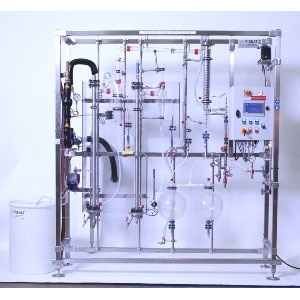Description
- Either be condensed in a condenser, in which case the process is known as “single effect” evaporation.
- Or be used to heat another evaporator, in which case it is known as “multiple effect”.
In theory an unlimited number of evaporators may be associated in series in this way. In industry evaporation is used to :
- Obtain crystallized sugar, concentrated milk, concentrated fruit juices, paper pulp.
- 1st stage at atmospheric pressure
- 2nd stage under vacuum
Observe the steps of the process
- Evaporation and climbing phenomenon
- Separation of a liquid-vapour mixture in a cyclone
- Condensation
- Reduced or atmospheric pressure
- Feed rate and steam flow rate
- Single or double effect
- Thermal and material balance
- Yield
General Specifications
- 50 L feeding tank.
- Metering pump.
- Glass shell evaporator, internal SS tube.
- SS refrigerant
- Glass cyclone.
- Solenoid valve.
- 2 glass shell evaporator, internal SS tube.
- Glass cyclone for vapor separation.
- 10 L glass graduated receiver with draining valve and vacuum connection.
- Diaphragm vacuum pump, diaphragm PTFE.
Instrumentation
- Temperature probes Pt100Ω.
- Flowmeter.
- Vacuum gauge.
- Manometer.
- Level sensor
For a complete product data sheet and a list of reference sites please call 1-877-967-2726.

